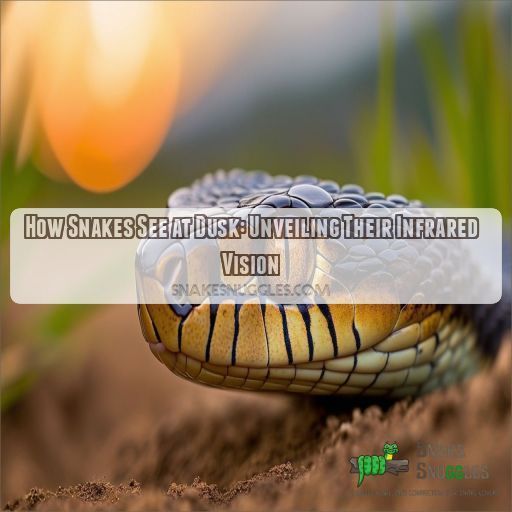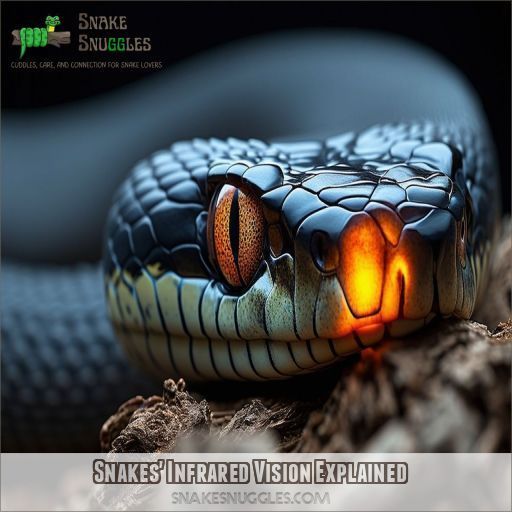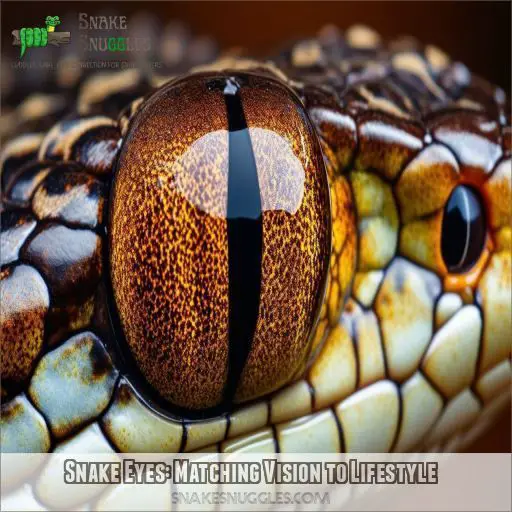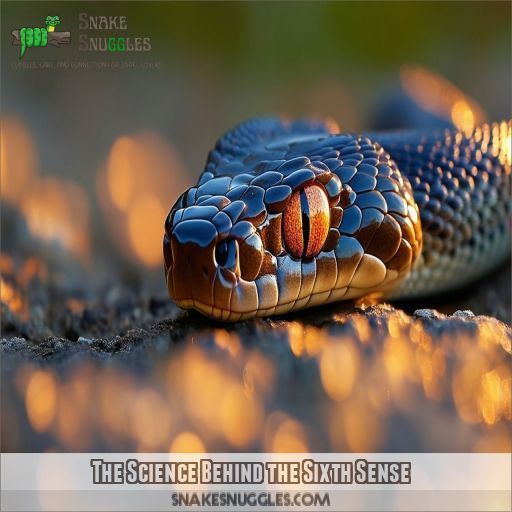This site is supported by our readers. We may earn a commission, at no cost to you, if you purchase through links.

If you want to know more about how snakes navigate and hunt at dusk, read on…
Table Of Contents
- Key Takeaways
- Snakes’ Infrared Vision Explained
- Snake Eyes: Matching Vision to Lifestyle
- Snakes on a Plain: Night Vision
- The Science Behind the Sixth Sense
- Evolutionary Significance and Future Research
- Frequently Asked Questions (FAQs)
- Are snakes active at dusk?
- How do snakes see at night?
- Do snakes see better in the dark or light?
- Do snakes come out in the evening?
- How do snakes see in pitch darkness?
- Whats the difference between snake and human vision?
- Do all snakes have night vision?
- Why is snake infrared vision so fascinating?
- How does this help us understand evolution?
- Conclusion
Key Takeaways
- Snakes have a built-in infrared sensor, the pit organ, which lets them see heat and detect prey at dusk and in total darkness.
- This organ, located between the eyes and nostrils, forms a thermal image, giving snakes an extra sense to navigate and hunt.
- TRPA1 proteins play a key role in heat detection, with higher levels found in the trigeminal ganglia, supporting the function of the pit organ.
- The ability to see infrared is an evolutionary advantage, offering survival benefits and providing insight into the evolution of sensory systems.
Snakes’ Infrared Vision Explained
Ever wondered how snakes find their prey in the dark? Well, certain species have a superpower of sorts – they can detect heat and see infrared radiation, allowing them to hunt with ease even at dusk or in total darkness.
In this article, we’ll explore the science behind this fascinating ability, diving into the realm of snake infrared vision and uncovering the secrets of their sixth sense.
The Pit Organ: a Snake’s Infrared Sensor
Vipers, pythons, and boas possess a unique ability to "see" in the dark thanks to their pit organs, a specialized facial feature.
These organs, located between the eyes and nostrils, act as infrared sensors, allowing snakes to detect heat and form a thermal image of their surroundings.
This infrared vision provides snakes with an extra sense, enhancing their hunting and navigation skills, especially at dusk and in low-light conditions.
How Snakes See in the Dark
Have you ever wondered how snakes navigate and hunt in the dark? It’s a fascinating ability that has long puzzled scientists. Certain species, like pit vipers and pythons, are masters of nocturnal hunting, but how do they do it? Let’s explore the secrets behind snakes’ infrared vision.
- The Pit Organ: The key to a snake’s night vision lies in a specialized organ called the pit organ, located between their eyes and nostrils. This organ acts as an infrared sensor, allowing snakes to detect heat.
- Heat Detection: The pit organ contains a membrane that detects infrared radiation, basically "seeing" heat. This membrane warms up as infrared radiation enters through an opening in the snake’s skin.
- Electrical Signal Conversion: The heated membrane activates specific receptors, generating an electrical signal. This signal is then transmitted to the snake’s brain, allowing it to locate warm-blooded prey or sense potential threats in low-light conditions.
The Role of TRPA1 Proteins in Heat Detection
TRPA1 proteins are key to how snakes detect heat. These proteins are more common in the cells of snakes with pit organs, and they help sense temperature changes. This mechanism is still a bit of a mystery, but it’s clear that it’s not just about seeing heat; it’s about feeling it, too. Think of it like this:
| Vision | Somatosensory System |
|---|---|
| Eyesight | Touch |
| Light Detection | Temperature Change Detection |
| Visual Image Formation | Heat Detection |
| Sensation of Warmth |
Comparing Trigeminal and Dorsal Root Ganglia
Researchers compared two types of sensory input processors: the trigeminal ganglia, which handle facial sensations, and the dorsal root ganglia, which manage sensations from the neck down. The trigeminal ganglia showed much higher levels of TRPA1, indicating its role in infrared detection. This difference in gene expression supports the idea that TRPA1 is essential to the pit organ’s function.
Snake Eyes: Matching Vision to Lifestyle
Snakes have evolved some pretty impressive ways to see in low-light conditions. In this section, we’ll explore how their unique vision matches their lifestyle and helps them navigate their surroundings, especially at dusk when the light is fading.
Amazing Eyes: Snakes’ Unique Visual Adaptations
You might be wondering how snakes see the world with their unique eye adaptations. Well, it turns out that snakes have a pretty cool set of visual tricks up their sleeves, or rather, in their eyes.
Snakes have a range of visual adaptations that help them navigate their surroundings and hunt effectively. From infrared vision to keen heat-seeking abilities, these reptiles have evolved some impressive ways to sense their environment.
How Do Other Animals See the World?
While snakes have their unique way of seeing the world, other animals also have their own distinct visual perspectives. From the sharp eyes of eagles to the echolocation of bats, the animal kingdom is full of diverse ways of perceiving the environment. Each species has evolved to perceive the world in a way that suits their lifestyle and survival needs.
Colour in the Collections: Reindeer Eye
Reindeer eyes are an intriguing example of how vision adapts to an animal’s environment and lifestyle.
While snakes rely on infrared vision to hunt in low-light conditions, reindeer have evolved to thrive in the Arctic’s extreme darkness and light variations.
Their large eyes, with a reflective tapetum lucidum, enhance their night vision and light sensitivity.
This adaptation helps them navigate and detect predators in the dark Arctic winters.
Snakes on a Plain: Night Vision
As the sun sets, snakes slither out, but how do they see at dusk? Can they see in complete darkness? It’s time to uncover the secrets of their night vision and explore their world after dark.
Are Snakes Active at Dusk?
So, are snakes active at dusk? The short answer is yes. Snakes are known to be crepuscular, which means they’re most active at dawn and dusk. This is when they do their hunting, slithering, and well, being snakey.
How Do Snakes See at Night?
So, how do snakes see their prey at night? Well, snakes like rattlesnakes, pythons, and vipers have a secret weapon: infrared vision. They can detect heat, which helps them find warm-blooded prey in the dark.
Do Snakes See Better in the Dark or Light?
Snakes see better in the dark. Here’s why:
- Snake eyes are well-adapted to low-light conditions, allowing them to hunt and navigate effectively at dusk.
- Their unique infrared vision gives them an extra sense, helping them locate prey and predators.
- This infrared vision is made possible by the pit organ, a specialized organ that detects heat.
- While the exact mechanism behind this heat detection is still a mystery, it’s clear that snakes have a remarkable ability to navigate and hunt in near-darkness.
Can Snakes See in Complete Darkness?
What on earth do snakes get up to after the sun sets? Can they see in complete darkness?
Well, certain species, like pit vipers and pythons, are master hunters in the dark. They’ve got a secret weapon—a special organ called the pit organ that helps them detect heat.
But how does it work? Scientists are still figuring that out, but they’ve made a breakthrough: soft, rubbery materials can have pyroelectric properties, and the pit organ cells might be using electrical voltage to act like a pyroelectric material, converting heat into an electrical signal.
The Science Behind the Sixth Sense
Ever wondered how snakes can see in the dark? Well, it turns out they’ve a special organ that lets them detect heat, giving them a sixth sense of sorts. Let’s take a closer look at the science behind this fascinating ability.
The way snakes see heat is actually pretty different from how they see light. Instead of using their eyes, they’ve a separate organ that detects infrared radiation.
Traditional Vision: How Snakes See Light
Snakes, like many other creatures, have evolved fascinating ways to perceive the world around them. While we often think of vision as solely reliant on light, snakes demonstrate a unique twist to this traditional sense. Here’s a glimpse into how snakes see the world through their own special lens:
- Light Sensing: Snakes possess the ability to detect electromagnetic radiation, specifically light, through their eyes.
- Pupil Shapes: The shape of a snake’s pupil can vary, and this influences how they perceive light. Some snakes have vertical pupils, which allow them to focus and see clearly even in low-light conditions.
- Color Vision: While snakes can distinguish colors, their color perception isn’t as advanced as that of humans. They can differentiate between colors with longer wavelengths, but may struggle with shorter wavelength colors.
- UV Light: Snakes are sensitive to ultraviolet (UV) light, which is invisible to humans. This sensitivity may assist them in hunting and navigation.
A Different Pathway: Snakes’ Infrared Detection
Unlike traditional vision, where the eye detects light through photons, snakes use a unique neurological pathway for infrared detection. Experiments by David Julius revealed this distinct mechanism, where infrared radiation is detected as heat inside the pit organ.
Heat Detection Mechanism: How Snakes Feel Heat
The mystery of how snakes detect heat is intriguing, and we’re here to shed some light on it. Imagine this: a snake, with its pit organ, can sense heat just like we might feel a warm breeze on our skin. It’s like having a superpower, but for snakes, it’s just their everyday reality.
Here’s how it works:
- The pit organ, located between a snake’s eyes and nostrils, acts as an infrared sensor.
- Infrared radiation (heat) enters the pit organ through an opening in the skin.
- Inside the pit organ is a thin, sensitive membrane that warms up as it absorbs the infrared radiation.
- This warming activates specific receptors, the TRPA1 channels, which are like a snake’s version of a "heat detector."
- The TRPA1 channels send a signal to the snake’s nerve fibers, allowing it to "feel" the heat and create a thermal image.
It’s a fascinating process that gives snakes a sixth sense of sorts, helping them hunt in low-light conditions.
Neurochemical Pathway: Snakes’ Heat-Sensing Ability
Snakes possess a remarkable ability to "see" heat, and this superpower revolves around a neurochemical pathway. Think of it like a superhighway in their bodies, with nerves and receptors working together to transmit signals and make sense of the world around them.
| Molecular Biology and Evolution | Understanding Snake Behavior |
|---|---|
| TRPA1 channels, or receptors, play a starring role in this process, similar to their role in detecting irritants like wasabi in mammals. | This heat-sensing ability provides valuable insights into how snakes hunt and navigate, helping researchers understand their strategies and behaviors. |
| In snakes, these TRPA1 channels are activated by heat, triggering a response that sends signals to the brain. | The study of this sixth sense opens doors to learning more about snake ecology and conservation. |
Evolutionary Significance and Future Research
Snakes’ ability to detect heat provides valuable insights into their hunting strategies and survival advantages. This discovery opens up new avenues for understanding the evolution of sensory systems and has potential applications in biomedicine and technology.
Sensory Adaptation: Snakes’ Heat-Seeking Ability
Snakes’ ability to detect infrared radiation and "see" heat is a fascinating example of sensory adaptation in the animal world. This evolutionary advantage allows them to hunt and navigate effectively, even in low-light conditions or total darkness. Understanding how snakes have adapted to their surroundings through the evolution of their sensory systems provides valuable insights into their behaviour and survival strategies.
The discovery of the TRPA1 protein‘s role in infrared detection opens up exciting avenues for future research. By exploring the specific mechanisms involved, scientists can enhance our understanding of sensory perception and evolution.
Independent Evolution of Heat-Seeking in Vipers
While boas and pythons also possess pit organs, vipers developed their heat-seeking ability independently. This independent evolution of heat-seeking in vipers is a fascinating example of nature’s ingenuity. It’s like each lineage stumbled upon the same hidden treasure, but through their own unique twists and turns.
Convergent Evolution: the Power of Natural Selection
The power of natural selection is evident in the convergent evolution of heat-seeking in vipers and boas/pythons. This remarkable ability showcases nature’s ingenuity:
- Natural Selection’s Power: The independent evolution of heat-seeking in vipers and boas/pythons showcases how natural selection drives innovative solutions.
- Survival Advantage: Heat detection provides a significant survival edge, enabling snakes to hunt efficiently in low-light settings.
- Herpetologists’ League: Natural history museum experts continue to unravel these mysteries, enhancing our understanding of snake behavior and evolution.
- Future Research: Unraveling the secrets of sensory adaptations in snakes can inform conservation efforts and provide insights into evolutionary biology.
Biomedical Applications: Understanding Pain Pathways
Understanding how snakes see in the dark has implications beyond just snakes.
It turns out that the TRPA1 channels, which are key to snakes’ infrared detection, are also related to pain pathways in mammals.
In humans, these channels are responsible for detecting irritants like wasabi.
This knowledge could lead to advancements in pain management strategies and a better understanding of our own sensory systems.
Frequently Asked Questions (FAQs)
Are snakes active at dusk?
You might wonder if snakes, those slithery creatures, are up to something when the sun goes down. Well, some snakes, like the sneaky ones, are indeed active at dusk, but they’re not just lurking in the shadows. They’re on a mission, using their special superpower to see in the dark.
How do snakes see at night?
Snakes detect infrared radiation through their pit organs, which sense heat. This triggers a nerve impulse, allowing them to ‘see’ in the dark. They can even hunt with their eyes covered.
Do snakes see better in the dark or light?
Snakes are definitely better than us at seeing in the dark. With their pit organs, they can detect infrared radiation, creating a thermal image to guide them. So, they’re pros at hunting and moving around in low-light conditions.
Do snakes come out in the evening?
Snakes are most active at night, but some species are also active during the day. Nocturnal snakes like rattlesnakes and copperheads hunt in the evening, after sunset, when temperatures are cooler.
How do snakes see in pitch darkness?
Ever wondered how snakes navigate in the dark? It’s all thanks to their pit organs, which detect infrared radiation, allowing them to sense heat and form thermal images. So, even in pitch darkness, they can find their way around.
Whats the difference between snake and human vision?
Snakes have poorer vision than humans, with less overlap in their field of vision. They also lack red cone cells, so can’t see red, and have a different depth perception.
Do all snakes have night vision?
No, not all snakes have night vision. Some species, like pit vipers and pythons, can hunt in total darkness thanks to their pit organ, a special heat-sensing organ. Scientists are still figuring out the exact mechanism behind this ability.
Why is snake infrared vision so fascinating?
Snake infrared vision is fascinating because it provides a unique insight into how certain species have evolved to adapt to their surroundings. It showcases the power of natural selection, with random mutations leading to similar solutions in independent lineages.
How does this help us understand evolution?
It shows how natural selection leads to incredible adaptations. This knowledge helps us understand how animals evolve to thrive in their environments, offering insights into survival and sensory evolution.
Conclusion
Ever wondered how snakes find their dinner at dusk?
Now you know it’s all thanks to their pit organ and infrared vision. From the pit organ membrane detecting infrared radiation to the activation of specific receptors and the creation of thermal images, snakes have a unique way of hunting and moving around in low-light conditions.
This article has shed light on the fascinating world of snake vision, their infrared superpower, and how it fits into their lifestyle.











